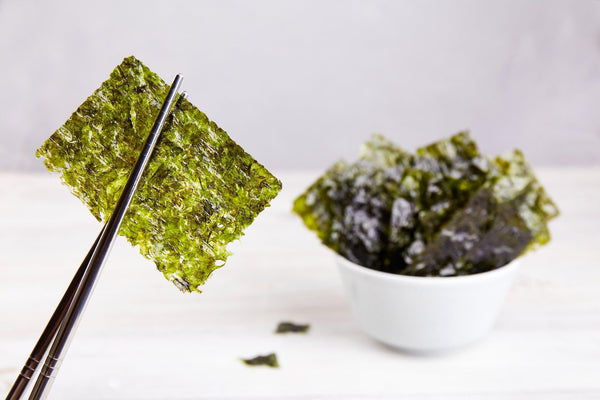
Jump to:
If you’ve ever eaten sushi, then you’ll probably recognize nori as the dark green seaweed used to wrap sushi rolls and Japanese rice balls. While nori is a type of seaweed, have you ever wondered where it actually comes from or how it is produced? Or why it has become such a popular staple? In this article, we’ll introduce nori seaweed and the different ways you can use it in Japanese and non-Japanese cuisine. We’ll also go over its health benefits, and where it comes from.
What Is Nori Seaweed?

Simply put, Nori is one of the main types of Japanese seaweed. It is often used as a wrapping for sushi or onigiri, cut into strips and used as a garnish, or is even cooked. Nori is traditionally produced in the coastal parts of Japan and has been consumed for centuries. It has become such a staple and popular food item that nowadays, it is commonly recognized overseas. You might have even seed nori featured in foods like salads or even topped on pizzas!
Nori is not only an everyday food for Japanese people, but it is also often used in Chinese and Korean cuisines. However, the shape in which it may come in (for example, Korean nori seaweed is often sold in packs of small, square-shaped pieces) may be different from what is found in Japan. (We’ll touch on this more a bit later in this article.)
History Of Nori
It’s not known exactly when nori seaweed first began being consumed in Japan. However, records show that nori had been known about as far back as 702 AD during the Asuka period. Nori was originally eaten wet, but by the time the Edo period came around, the demand for preserving nori grew amongst commoners. At this time, nori was often shredded and dried naturally under the sun. The method of preserving nori not only expanded its shelf-life but also heavily influenced current-day nori production. This method of preserving the nori is how nori developed its thin, paper-like sheet appearance that it is well known today for.
How Is Nori Produced?

As previously mentioned, nori production mainly takes place in the coastal regions of Japan. Most nori is farm-raised in the cold sea regions of Kyushu, the Seto Inland Sea. Tokai, Chiba, and Miyagi. Before nori can be sold in dried sheets or strips commonly found in supermarkets, it must go through a somewhat of an intense harvesting period.
Nori cultivation season starts in spring. You may think that nori, similar to other seaweed, just comes from the ocean. But the process of cultivating nori is much more complicated than that! Nori basically comes from gendered fonds or seedlings that mate together in the spring. Once a male and a female fond come together and are fertilized, they create what is called a carpospore. The carpospores are placed into oyster shells where they are left to grow all summer long. During mid-September or early October, the carpospores finally germinate (they are called seeds at this point) and nori production can move along to the harvesting stage.
Once the autumn months roll around, the nori seeds can be collected and then planted onto nets. The way in which the nori is planted depends on a multitude of factors such as the size of the nori, the weather conditions, the farming location site, etc, but they are left to grow and harvest until May of the following year.
After the nori is harvested, it is cut into smaller pieces, washed, and dried. The drying method used is the same method that Washi paper (traditional Japanese paper) is dried. Nori is then strictly inspected for quality, color, luster, and taste before it can be consumed. Many nori manufacturers often opt to take an additional roast and/or season their nori to improve its taste before they package and sell it to consumers. That means in total, it takes over one year just to produce the nori found in grocery stores!
Is Nori Seaweed Healthy?

Nori is not only popular for its taste, but also has many health benefits. It is rich in vitamins, minerals, and dietary fibers. Nori is naturally high in vitamin C. In fact, five standard-sized sheets of nori contain 1.3 times more vitamin C than one mandarin orange. About 30% of nori’s nutritional makeup is dietary fiber. That means one sheet of nori has roughly the same amount of fiber as a banana or a tomato. Surprisingly, nori is naturally high in protein too. In fact, it contains more protein than soybeans, however, it lacks amino acids. By eating nori with soybeans (in the form of natto, for example), you could have an excellent, healthy, nutritionally-balanced meal. The added protein from nori doesn’t hurt in maintaining muscle health either.
Three Types Of Nori You Can Buy And How To Use Them
While raw nori can be purchased, many nori manufacturers roast their nori before packaging it. Toasted nori is more common because it is already dried and ready to use. You can find it sold in Japanese and Asian supermarkets labeled as yaki-nori. There is also seasoned nori, called ajitsuke-nori in Japanese, which is usually seasoned with soy sauce, mirin, and sugar. Below, we’d like to outline the forms in which nori is sold and how to use them in everyday cooking.
Nori sheets

This is the most common type of nori found in supermarkets. They are easy to cut and are used for making sushi rolls and onigiri rice balls. They have a crispy texture and deliciously natural salty and umami flavor, so you can eat them as is, too.
You can also purchase smaller nori sheets packaged in a plastic film which is really easy to use when wrapping onigiri, or sushi hand rolls. If you want to incorporate nori sheets into non-Japanese cooking, try using them as a wrapper for other foods like tacos!
Kizami Nori (Thin Nori strips)

Kizami nori is nori that has been sliced into thin ribbons. This kind of nori is usually used as a topping for salads, pasta, or as decorative seasoning on dishes like noodles and donburi. It is even featured on Japanese pizza sometimes!
Nori Paste

This may seem a little odd, but don’t knock it til you try it! Perhaps similar to laverbread found in Wales, nori paste (called nori tsukudani in Japanese) is exactly what it sounds like. It is nori that has been turned into a paste and seasoned with seasonings such as soy sauce, mirin, or even dashi. It can be eaten atop a bowl of rice or mochi rice cakes, or can even be spread on a piece of toast.
How To Cook Nori
You can also add nori to soups, stews, or even stir-fried dishes if you’d like. In order to use it in cooking, nori should be soaked 20 minutes prior to being cooked. It should also be squeezed of its excess moisture to become more pliable and easier to cook. The reason why it should be softened is to prevent it from sticking to the sides or bottom of the pan during cooking.
Is Nori Vegan Friendly?

Yes, of course nori is vegan-friendly! As a healthy plant-based product, nori is the perfect ingredient to add extra umami flavor to vegan dishes. Try making vegan-friendly onigiri filled with tofu or cucumber, or even homemade nori furikake seasoning to put on top of rice. Nori is also an excellent replacement for dishes where you want to imitate the seafood flavor of fish.
How To Store Nori Seaweed
Nori seaweed should be kept refrigerated after being opened because it is vulnerable to heat and humidity. After opening, keep your nori sheets in an airtight and moisture-proof container to preserve their taste and freshness.
Other Nori-Based Japanese Products
Since nori is such an essential part of the Japanese diet, it has naturally become loved by both children and adults in Japan. To cater to this, many food manufacturers have found ways to incorporate nori into other Japanese seasonings, dishes, and snacks. Here are some other ways that feature nori.
Furikake

Furikake is probably one of the most common cases where nori seaweed is featured as a main ingredient. If you’re unfamiliar with furikake, it is a Japanese seasoning meant to be paired with rice. While not every kind of furikake contains nori, it is probably more common to see it as an ingredient than not.
Chazuke

Chazuke or ochazuke is another dish where nori is often featured. The concept of chazuke is to pour hot green tea or dashi over a bowl of rice and toppings such as salmon, but these days there are a lot of instant products to make enjoying this dish much easier. Premade chazuke packs often contain nori strips as an ingredient to add an extra layer of umami.
Rice Crackers

Another way in which nori is commonly used in Japanese snacks is with senbei rice crackers. It is not uncommon to find nori sheets being wrapped around rice crackers to add another level of flavor and crunch.
Nori Chips

Sometimes, nori is even turned into chips too! You can find nori used in tempura chips, in which they are coated in tempura batter, fried, and then seasoned. There are also nori chips that are grilled and then flavored, which is a bit of a healthier option. Both ways are equally as delicious, it just comes down to your personal preference in deciding which version of nori chips you think is more delicious.
Besides being turned into actual chips, nori is also used as a seasoning for potato chips in Japan. You might be familiar with Norishio Potato Chips which are seasoned with powdered nori seaweed and salt. Interested in trying other nori seaweed snacks? Be sure to check out this article.
Where To Buy Nori
Now that we’ve covered all of the ways that nori comes in and can be used in Japan, you might want to purchase it for yourself. These days you can buy nori seaweed easily from Asian supermarkets and health food stores. However, if you want to try authentic and high-quality Japanese nori, then the Japanese Taste store has a wide selection of nori products that you can order online to be shipped directly to your door. Browse the selection here.
What are your thoughts about nori? Have you tried it before? Let us know in the comments below.


0 comments